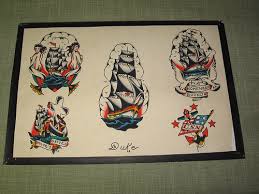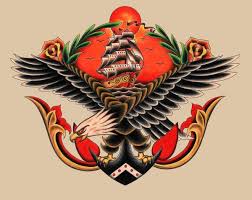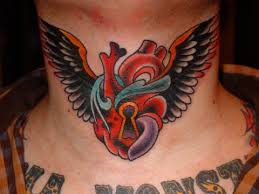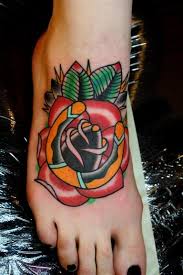 |
Tattooing has been a Eurasian practice at least since Neolithic times. Ötzi the Iceman, dating from the fourth millennium BCE, was found in the Ötz valley in the Alps and had approximately 57 carbon tattoos consisting of simple dots and lines on his lower spine, behind his left knee, and on his right ankle. Other mummies bearing tattoos and dating from the end of the second millennium BCE have been discovered at Pazyryk on the Ukok Plateau. Tattooing in Japan is thought to go back to the Paleolithic era, some ten thousand years ago. Various other cultures have had their own tattoo traditions, ranging from rubbing cuts and other wounds with ashes, to hand-pricking the skin to insert dyes.
Tattoos have experienced a resurgence in popularity in many parts of the world, particularly in North America, Japan, and Europe. The growth in tattoo culture has seen an influx of new artists into the industry, many of whom have technical and fine art training. Coupled with advancements in tattoo pigments and the on going refinement of the equipment used for tattooing, this has led to an improvement in the quality of tattoos being produced.
During the 2000s, the presence of tattoos became evident within pop culture, inspiring television shows such as A&E's Inked and TLC's Miami Ink & LA Ink (Tattoo Tv). The decoration of blues singer Janis Joplin with a wristlet and a small heart on her left breast, by the San Francisco tattoo artist Lyle Tuttle, is taken as a seminal moment in the popular acceptance of tattoos as art.
Lower back tattoos are more common among young women. In many traditional cultures tattooing has also enjoyed a resurgence, partially in deference to cultural heritage. Historically, a decline in traditional tribal tattooing in Europe occurred with the spread of Christianity. A decline often occurred in other cultures following European efforts to convert aboriginal and indigenous people to Western religious and cultural practices that held tattooing to be a "pagan" or "heathen" activity. Within some traditional indigenous cultures, tattooing takes place within the context of a rite of passage between adolescence and adulthood.
A poll conducted online in July 2003 estimated that 16% of all adults in the United States have at least one tattoo. The highest incidence of tattoos was found among the gay, lesbian and bisexual population (31%) and among Americans ages 25 to 29 years (36%) and 30 to 39 years (28%). Regionally, people living in the West (20%) were more likely to have tattoos. Democrats were more likely to have tattoos (18%) than Republicans (14%) and Independents (12%); approximately equal percentages of males (16%) and females (15%) have tattoos.
|
 |
Tattoos on girls are sexy, most people will agree on that. The part of picking a tattoo can be difficult if you do not have a good idea of what you want. Most people will look at the more popular tattoos and girls are no exception to this. Here are a few popular tattoos for girls.
1. Traditional American tattoos - these include nautical stars, swallows, pin-ups, classic American cars and sailor jerry tattoos.
2. Floral tattoos - Girls love flower tattoos. It may be because they think they are pretty or it helps to accent their feminine features. Sometimes these are combined together to form a full "sleeve" tattoo. These flower tattoo designs can include orchids, peonies, lotus flowers, and you will often see flowering vines as the most popular.
3. Anime - The Japanese anime tattoos have become more popular over recent years.
4. Irezumi or Traditional Japanese tattoos - These may include dragons or Koi fish and other traditional Japanese designs.
5. Indian or Hindu tattoo designs
These are only a few suggestions and you will have to consider many things when you decided on a tattoo. You may want to incorporate your unique style into your tattoo by making changes to a design that you like. The size can also play a role; most tattoo places will be able to re-size a tattoo for you if you ask, so that it fits where you would like it.
No mater what design you choose you should remember to keep this a fun experience. You will have your tattoo for the rest of your life; take the time to pick out one that you will enjoy. |
 |
Tribal Sleeve - Leo Zulueta is credited with bringing tribal style tattooing from the South Pacific to the United States in the late 70's. But is was George Clooney's character in the movie From Dusk Till Dawn that caused the tribal sleeve to explode in popularity. Tribal sleeves may be the worst sleeve trend of all as they take another peoples tattoo culture, remove all the meaning and mock the origins of tattoo designs that date back centuries. They are also next to impossible to cover up once tattoo regret sets in.
Biomechanical Sleeve - Biomechanical tattooing was pioneered by tattoo artist like Aaron Cain and other tattooist in the San Francisco bay area. A breakaway from traditional style American tattooing, biomechanical uses images of the human flesh mixed with machine parts. Basically biomechanical tattoos mix organic images with inorganic images. It quickly became over used.
Flame Sleeve - No clear origins on the flame sleeve but whoever created it should be ashamed. The sleeve is not only hard to look at but is unbelievable boring for the tattoo artist. Flame tattoos are not only a waste of good skin but will also prove difficult to cover.
Random Cool Stuff Sleeve - A twist on the American style hodgepodge sleeve that is acquired over time, the random cool stuff sleeve is acquired quickly. The images often include skulls, flowers, brass knuckles, something with wings,maybe a couple of flames. A newer variation on this sleeve is to get random candy pieces or random kids toys tattooed as a sleeve. |
 |
Just a look at search engine figures for tribal tattoo design would be enough to tell you that it is one of the most sought-after designs. There is however, more to getting a tribal tattoo design than just picking a generic set of unidentifiable curves and lines. If you are interested in getting a tribal tattoo, you should take note of a couple of things.
Tribal Tattoos
Before you get a tribal, ask yourself first what a tribal tattoo design really is. The term "tribal" is already a clue to the nature of this particular tattoo category. A tribal design is most often an original figure or a modified one that draws its roots from real tribes today or of long ago. Since tribes that perform tattooing were or have been around for centuries in different continents, this particular category can have a very broad scope. A tribal tattoo design can therefore trace its origins among tribes belonging to the Maori, American Indian, Samoan, Incan, Aztec and Hawaiian traditions. Of course, these are not the only tribes in the world. There are countless more with their own unique tribal tattoos.
In other words, an original tribal tattoo design is supposed to identify an individual as a member of a particular tribe. Within a specific tribe, there can also be variations to a tattoo design. Differences in designs and placement of tattoos in a tribe can tell such things as social status, role in the tribe, skill and family affiliation.
Why People Get Them
Now, anyone can simply get a tribal design for various reasons.
- One common reason would still be to mark oneself as a member of an ancient or old tribe. Some young American Indians for example would want to get a traditional tattoo associated with their tribe to identify them as modern but true members of that tribe. A tribal tattoo design is therefore a link to an individual's historical and cultural identity.
- For some people who do not really belong to a specific tribe, tribal designs are a way for them to express their own sense of style, fashion, freedom and individuality. For some, tribal tattoos communicate who they feel they truly are.
- Tribal designs are also known to be simply exquisite and beautiful. A tribal tattoo design has strong bold lines and curves that makes it eye catching. You can pick designs that are intricate or simple.
Design Categories
Here are the three major categories of tribal tattoos:
- Authentic - These are original tribal designs coming from actual tribes. Some designs are difficult to find especially if the tribe of origin no longer exists. If you want one you may have to perform some extensive research first.
- Adaptations - Many tribal designs are really just adaptations of original ones. An artist may have been inspired by an ancient pattern and created his own unique tribal tattoo design.
|

When you make a decision to get permanent art put on your body, you have to make sure that the design you get is going to be something that you will continue to like for the rest of your life. Tattoos are a forever mark of some of the most amazing artwork in the world. Some people get stuck with tattoos that are not very attractive and then they end up paying a lot of money to get them removed, and some just can not afford to get them removed. Make sure that the design you pick really means something to you. Maori designs may have just what you are looking for.
The majority of Maori artists that come from centuries back, have made many of their art works based on the design of nature. They were sincerely inspired by the artistic designs that nature had to offer them. Their form was more of an abstract type of art than you would expect. They would also display different kinds of symbols in their art work. Tie all of this together and you can get some of the most beautiful art that would nearly speak to you in song as you gazed upon it.
Maori design tattoos are a type of Polynesian tattoo art coming from Eastern Polynesia. These tattoos have a lot of different curved shapes that form their designs. They also use a lot of spirals in their tattoo designs, because they are literally based on the curve of a spiral. Traditionally, the ancient people would permanently decorate their entire faces with these beautiful spirals. They also took a more painful way of tattooing, they would chisel their designs into their faces which is much different than the methods that we use today.
These tattoos were actually called by a different name than what we now call them, they were called Ta moko. " Ta" translates to the meaning of striking or tapping. It basically defines the traditional manner in which they would give tattoos. "Moko" translates to describe the finished design as a whole piece. The face was not always the place to put these, just the most common of the Maori people who lived in the colder climates.
For the most part the Maori tattoo designs have stayed the same no matter what part of the world the happen to appear in. Some cultures have made a few slight changes over the years, but none of the changes have been drastic enough to literally change the design and the name of the design. Even in the American tattoo culture the Maori tattooing has made a come back, and in some areas these tattoos are even being done in the traditional chiseling manner. These have proven to be some of the most attractive tattoos no matter which ones you see. Their appearance induces an almost nostalgic feeling in the mind of the person who is viewing them. Maori tattoo designs are making a come back in today's culture.